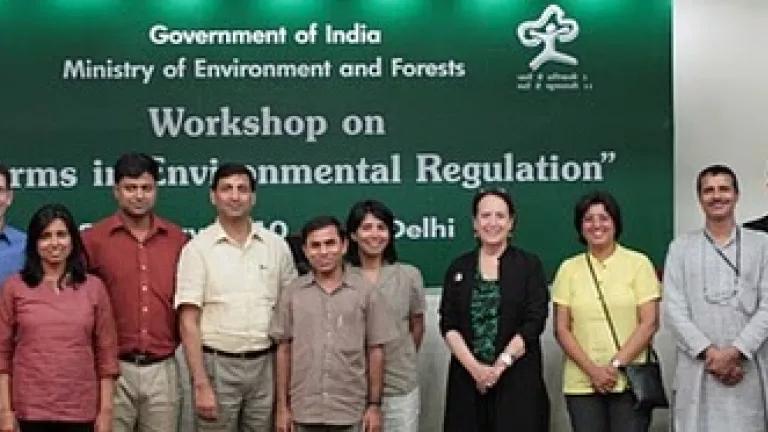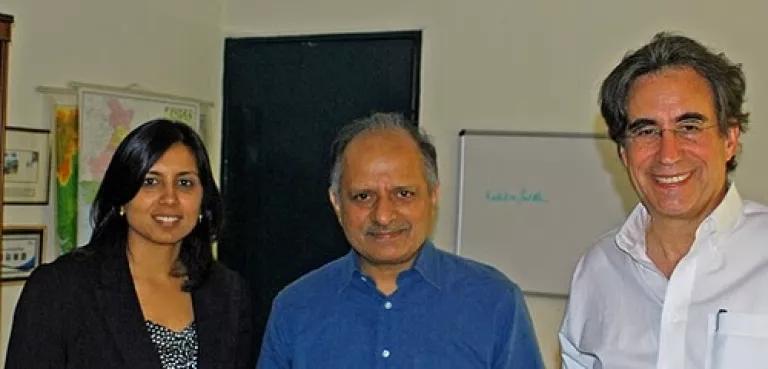
NRDC’s India initiative hosted a dialogue with Indian civil society and NGO’s to share perspectives on environmental compliance and governance in India, China, and the US in late May and early June. In addition to participating in the Ministry of Environment and Forests’ Workshop on “Reforms in Environmental Regulations” that I wrote about earlier this month, NRDC’s team had extensive discussions with Indian civil society leaders about their experiences in working to strengthen environmental governance. Joined by Felicia Marcus, Jacob Scherr, Alex Wang, Michael Thompson and Professor David Adelman, we learned a lot and were also able to share our views on environmental compliance and governance based on NRDC’s decades of experience protecting the environment in the US and elsewhere.
Over 20 representatives from various India civil society groups from Delhi, Gujarat, and Uttar Pradesh attended the NRDC civil society discussion at the World Wildlife Fund Auditorium. We also had several separate conversations with groups based in Delhi, Bangalore, and Hyderabad.
One of the main areas of discussion was how the process of environmental review by government agencies occurs in both countries. Videh Upadhyay and other Indian experts explained their view that one of the biggest problems for environmental compliance in India is the government’s review of environmental clearances and Environmental Impact Assessments (EIAs). Given the accelerated rate of development in India, the Ministry gets over 60 project clearance applications a day. This is in addition to the applications submitted to the State Pollution Control Boards. Both the Ministry and the Central Pollution Control Board are historically under-resourced and unable to provide thorough review or full public notification and participation. Felicia Marcus, NRDC Western Director, explained that these processes are slow in the United States and that the environmental reviews are conducted by various state and federal agencies so EPA doesn’t have the sole responsibility for review. We also compared staffing differences, where US EPA has 17,000 employees and a 2010 budget of $10 billion whereas the Ministry of Environment and Central Pollution Control Board have less than 2,000 staff combined. The group agreed that good governance requires expert staff and resources to strengthen agency capacity.
During the group discussion, Felicia Marcus, Alex Wang, Michael Thompson and myself, as well as Professor David Adelman from the UT Austin Law School, spoke about the US and China experience in environmental governance and compliance. Felicia Marcus described the role of nonprofit organizations, like NRDC, in strengthening compliance and governance through advocacy, legislation, and citizen suits. She also explained US EPA’s agency structure based on Felicia’s eight-years of experience as EPA Region 9 Administrator.
Felicia described some of the strengths of the US system: extensive federal and state interaction with strong federal oversight and a wide array of compliance tools, including the federal government stepping in when state agencies fail to do what federal law requires; deep scientific, legal and policy expertise w/emphasis on training, tool development, and continuous improvement; extensive integration of NGO involvement in administrative processes and citizen suits; and various tools include administrative enforcement, self-monitoring, and incentive programs. She also discussed some of the challenges of the US system: the various 28 statutes can be cumbersome; the complex bureaucracy associated with implementation of these separate statutes can be disjointed and inefficient; and the system’s success depends heavily on leadership from individuals in the federal and state systems.
Alex Wang, Director of NRDC China Law Program, gave an overview of environmental protection in China. He explained that although the countries are very different, there are many similarities in the stage of economic development for both countries and the challenges they face. Alex described three positive trends in China for environmental protection: a focus on priority pollutants (SO2, COD) with support at most senior levels on energy efficiency and climate; shut down of most backwards technology with rapid replacement with more advanced technologies; and increasing transparency and public participation. He also discussed the similarity of some of the challenges that India faces with swift development and urbanization and need for increased capacity and expert knowledge.

Our Indian colleagues asked for more information about self-monitoring and self-reporting requirements and the various tools for administrative, civil, and criminal authority. We shared our views on what works and what doesn’t work in the US in terms of self-monitoring and administrative enforcement authority. Some of the Indian experts also discussed the view that a new agency, as proposed by the Ministry, is not the solution and more resources should be put into existing structures while others were more open to a new agency as a means to transform the institutional culture for compliance and governance in India.
In anticipation of these meetings, NRDC India team members, Avinash Kar, Shravya Reddy and myself, along with the Nikhil Vijakar, a UC Berkeley Law student, and Simi Bhat, Albert Monroe, and Brad Tennis from the Yale School of Law Environment Clinic prepared a draft paper, Effective Environmental Compliance and Governance: Perspectives from the Natural Resources Defense Council. The draft paper discusses some of the key principals for environmental compliance and governance in the US including:
- Clarity and coordination between federal and state agencies
- Retaining highly qualified professionals and dedicated agency resources
- Monitoring by regulated entities: self-monitoring and self-reporting
- Incentive and outreach compliance programs
- Agency enforcement tools: administrative, civil and criminal authority
- Agency Accountability
- Transparent and meaningful public participation
- Citizen Suits
Based on ongoing discussions with our Indian colleagues over the next few months, we plan to modify the draft paper into a final report later this summer before our next visit to India. In the meantime, we’ll continue the dialogue with experts to learn more about environmental governance and compliance in India and to share our perspectives from the US and elsewhere.
(Photos by Alex Wang, Jacob Scherr, NRDC)